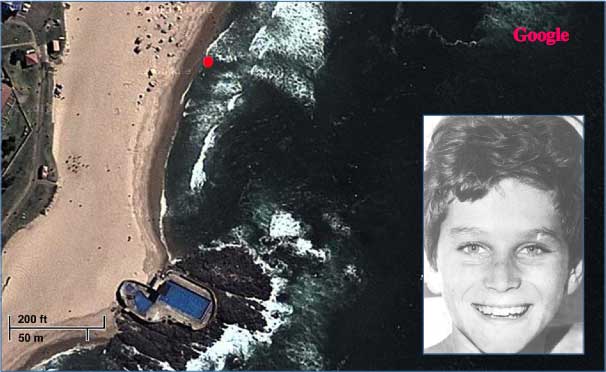Damon Kendrick
Damon Kendrick is a South African provincial diver, surf lifesaver, and Australian master's swimmer - despite losing a leg in a shark attack at age 14.
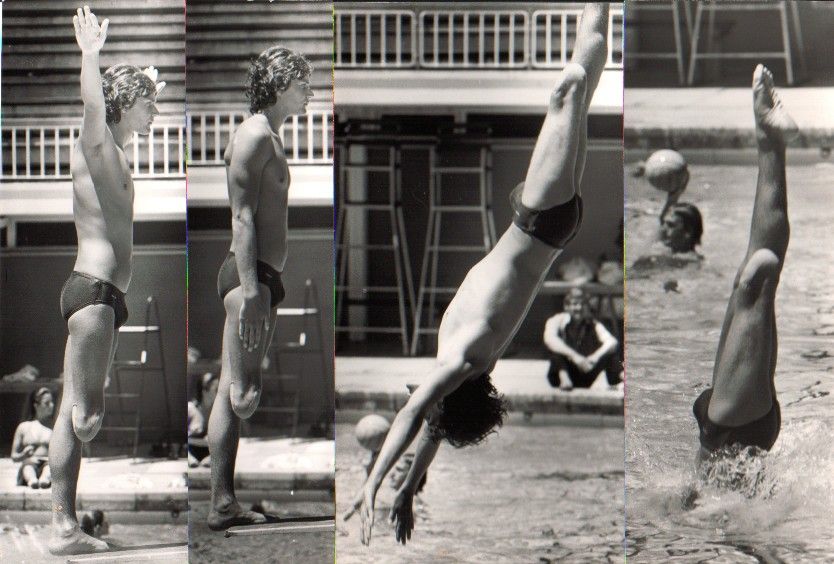
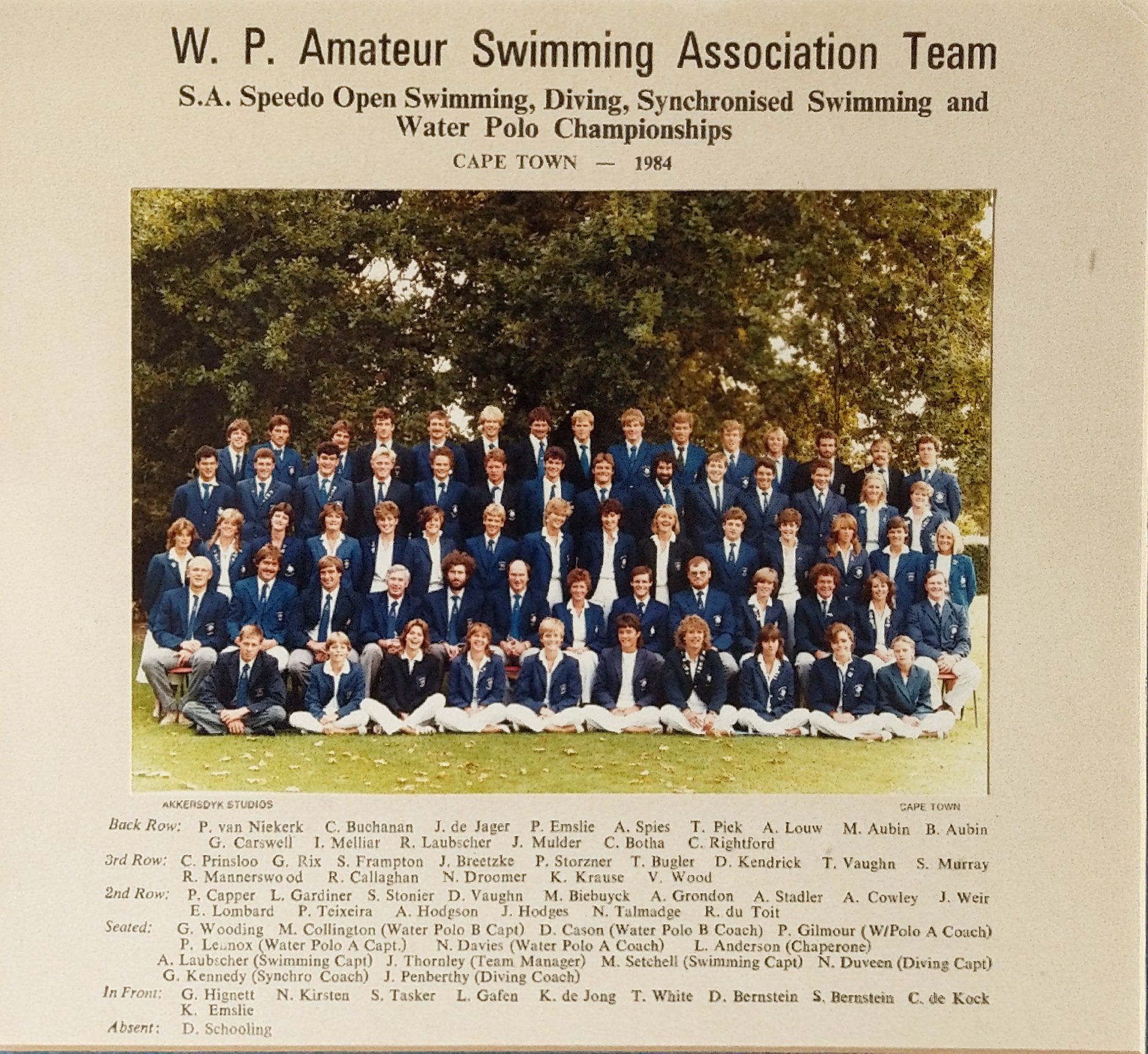
Damon Kendrick diving for Western Province at the South African Championships at Newlands in Cape town.
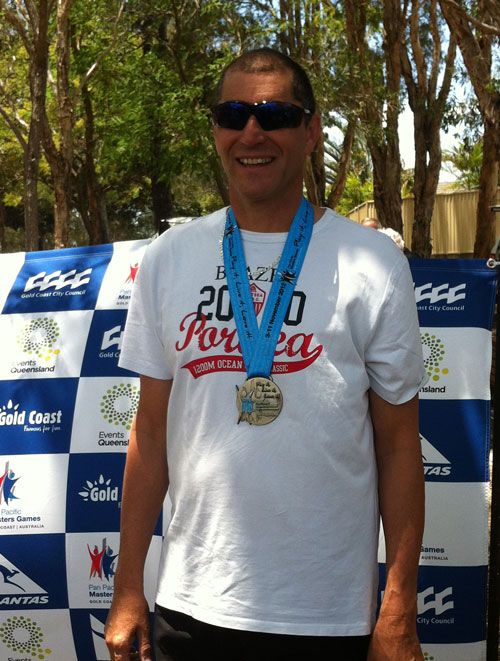
2010: The Zimbabwe-born 53-year-old, who now lives at Ermington in NSW, took the gold medal in the 5km open water swim (50-54 age group) today (Sunday) at the Pan Pacific Masters Games at Lake Hugh Muntz on the Gold Coast.
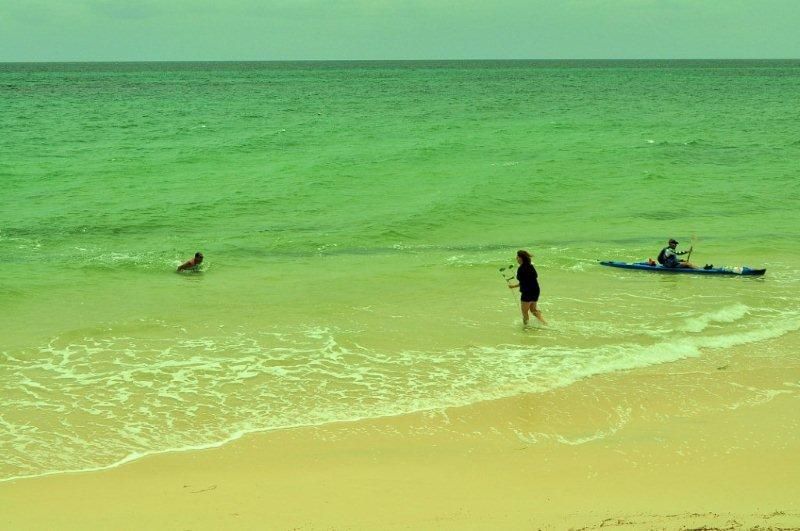
Damon's entry in the Openwaterpedia:
- First amputee to complete the 19.7 km Rottnest Channel Swim, February 2011
- Won 2 gold medals, 2 silver medals, 1 bronze medal at the 2010 Pan Pacific Masters Games vs. able-bodied competitors
- Won 4 gold medals and a silver medal at the 2009 World Masters Games
- Won 5 gold medals at the 2005 World Masters Games
- Compete in springboard diving
- Is a flying trapeze artist
- Completed the 105 km Argus Cycle Tour
- Won the overall title at the 2011 20 km Geo Bay Swim in Western Australia
Damon’s 50th Sharkversary - 10th february 2024
On 26 February 2011, Damon swam the Rottnest Channel Swim, solo. He finished in six hours, fifty minutes.
Born in Zimbabwe to a mother who coached swimming, Kendrick says he “could basically swim before [he] could walk.” After moving to Durban, South Africa, when he was young, his family became involved in the city’s lifeguard club. As part of his training, Kendrick learned to treat shark-bite victims. But even after an attack occurred at his local beach when he was 14, he didn’t worry about being bitten himself. When an anxious girl approached his lifeguard chair after the attack to ask if the water was safe for swimming, he responded: “It’s a once-in-a-lifetime occurrence. It’s never going to happen again.”
“The thought of being eaten while still alive was the hardest thing to understand,” he says. “Once you realize you’re part of the food chain—not sitting on top of it—it’s really difficult.”
Three weeks later, Kendrick was swimming with other trainees when a shark attacked one of the boys in the group. Kendrick swam furiously toward shore. He was about to set his feet down, just yards from the sand, in water that was less than waist deep, when he felt himself pulled backwards and underwater. Experts would later say that likely a bull shark had clamped down on his calf, shaking him vigorously. The shark ultimately released him, but the bite was severe enough that doctors were forced to amputate his right leg below the knee. (The other boy’s injuries required only stitches.)
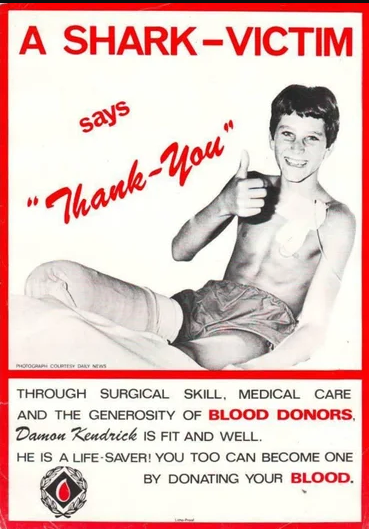
Damon Kendrick, about 36 hours after his attack.
After recovery, Kendrick quickly got back into competitive diving, a sport at which he’d excelled before the attack. Even with just one foot to push off of, he racked up multiple national championships. Later he threw himself into equestrian sports, dominating those, too. Eventually, he fell in love with open-water swimming and moved to Australia, where he frequently competed.
As he glided through the water during races, he’d often think of sharks. Recalling what a former swim-competition rival once called him, he created a mantra to repeat whenever he felt afraid: “I am a dolphin. I am a dolphin. I am a dolphin.” Dolphins are known not only for their speed and grace but also for their ability to defend themselves against sharks.
A few years ago, Kendrick had an urge to connect with other shark-attack survivors; after decades of healing, he thought he might be helpful. He joined the Bite Club Facebook group, and soon after, Pearson rode his motorbike to where Kendrick was living. The pair “got on like a house on fire,” says Kendrick. Like Pearson, he also began making hospital calls on new attack survivors in Australia. When survivors had to undergo amputations, Kendrick would regale them with stories of his athletic triumphs as a uniped, telling them, “You’re no less of a person.” Mostly, though, he assured them that they were not alone.
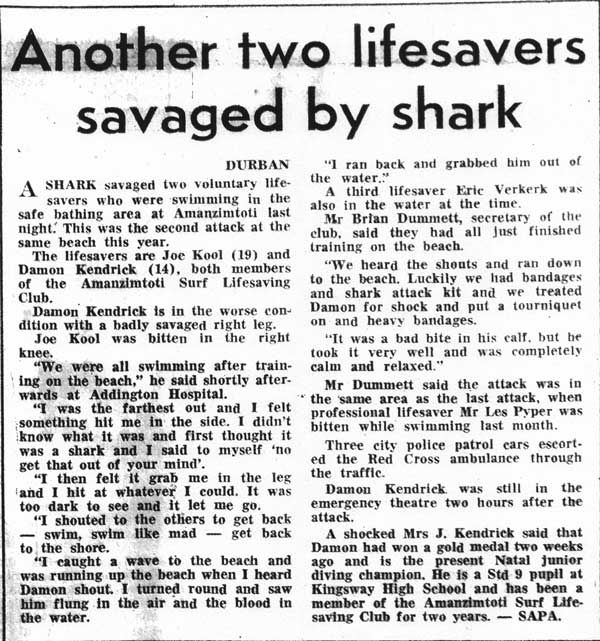
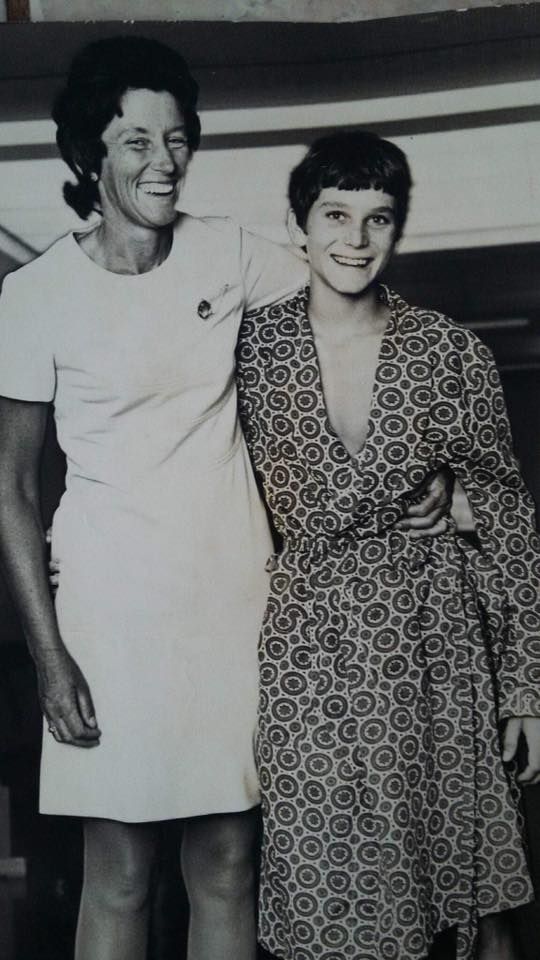
Shark attack victim jumps straight in the deep end
A shark attack at just 14 years of age that left him an amputee and put a halt to his teen surf-lifesaving dreams didn't stop Damon Kendrick from facing his fears and getting back in the water.
In fact, it was just a matter of months before he was swimming again, competing in springboard diving for more than nine years in his native South Africa.
And now, 36 years later, the WAtoday Rottnest Channel Swim may just be the ultimate test.

Damon Kendrick swims at least five kilometres, four to five days a week.
Nearly 20km of open seas can play tricks on a person's mind, and according to Damon, the mental side of the race is much harder to overcome than any physical barriers he may face.
"I love the water and the sea, and I have always swum competitively," he said.
"But I have never been back to that same beach where I was attacked."
It was the summer of 1974, and Damon was one of dozens of lifesavers on a beach near Durban, preparing for their championship competition.
"We were about 25m from the shore, all of sudden this guy just said 'Swim for shore, swim for shore'," he said.
"What I didn't know was that the shark had bumped him, and sharks tend to bump you and then circle around and come back in to bite.
"I didn't know that it had bumped him, and then come back and lacerated his knee and shin and that he was trailing blood through the water.
"I was swimming to shore just behind him, swimming through the blood.
"About three metres from shore, in 1m-deep water, I was just about to put my feet on the ground and start running."
It was then that the shark grabbed him by the leg, shaking him. His leg was so badly ravaged it needed to be amputated below the knee.
Luckily, Damon has a sense of humour, and said despite having a great 'scary story' at his disposal ahead of the WAtoday Rottnest Channel Swim, said he won't be using it to psych-out his opponents.
"On a long swim like that, your mind plays tricks on you, and it's more of a mental challenge," he said.
"It's stopping the negative chatter that goes on in your head."
Damon is confident that his training regime, swimming at least 5km four to five days a week, will be more than enough preparation for the 19.7km haul on the weekend.
"I have no doubt that I'll finish," he said.
"Ideally I would like to finish in under six hours, that would be great.
"A lot of it obviously depends on the conditions on the day."
Now in its 21st year, the WAtoday Rottnest Channel Swim is being held on Saturday, February 26.
Thousands of swimmers will depart from Cottesloe Beach at 5.45am, making their way 19.7km to the finish line at Thomsons Bay on Rottnest Island.
Shark Attack report
ACTIVITY:
Swimming
CASE:
GSAF 1974.02.13.b
SA-232
DATE:
Wednesday February 13, 1974
LOCATION:
The incident took place in the Indian Ocean at Inyoni Rocks, Amanzimtoti, 26 kilometres southwest of Durban, Natal, South Africa.
30°03'S, 30°53,4'E
_________________________
NAME:
Damon Kendrick
DESCRIPTION:
The swimmer, a 14-year-old male, was 1,68 metres tall, weighed 42,7 kilograms and was clad in a red-orange speedo. He was well-tanned, wore no jewelry and had no injuries before the accident. Kendrick was the current Natal Junior Diving Champion.
BACKGROUND
WEATHER:
The weather was hot; temperature ranged from 24° to 27,7°C. The sky was cloudless and during the morning there was a light southwesterly breeze. Shortly after noon the wind changed to south- southwesterly, finally dropping completely at 19h00.
MOON PHASE:
Third Quarter, February 14, 1974
SEA CONDITIONS:
For some weeks prior to the incident, Natal had been experiencing heavy rains in the interior. As a result most rivers were in flood and emptying into the sea.
The flood conditions caused a marked water turbidity and deposited large quantities of plant debris and animal remains in the sea. Three metres from shore there was a wide channel where waves were reforming and breaking on to the beach. Water visibility in the surf zone was zero, and was only 1,2 metres beyond the backline. The sea temperature was 24ºC and high tide occurred at 17h46.
Large waves 1,2 metres in height were breaking on a sandbank about 175 metres from the beach. The waves rolled across the sandbank and reformed in a channel between the sandbank and the beach before breaking on the shore. The shorebreak had eroded a steeply shelving bank at the water's edge and created a close inshore channel, the incident took place seaward of this channel. A rip current flowed out to sea adjacent to Inyoni Rocks.
CONDITION OF THE SHARK NETS:
On February 6, 1974 surf conditions deteriorated making launching of ski-boats impossible. Large surf and rough seas persisted until the day after the attack. The nets had not been serviced for seven days and bathing was banned.
Inspection of the shark nets immediately after the attack revealed that five of the nine nets were severely bunched.
DISTANCE FROM SHORE:
The accident took place five metres from shore in the bathing area on the northern side of Inyoni Rocks.
DEPTH:
One to 1,5 metres
TIME: 19h01
NARRATIVE:
An official life-savingclub training period for the voluntary life-savers of the Amanzimtoti Surf Life-saving Club was held from 17h00 to 19h00. Five life-savers had entered the sea about 18h50 and body-surfed a few waves before returning to shore. Damon
Kendrick, Joe Kool and Eric Verkerk ran into the water at 18h55. They swam out about 15 metres and were body-surfing in the shorebreak as they swam northwards, parallel to the beach. Kendrick was 10 metres from shore, Kool was five metres seaward of him and Verkerk was seven metres south and slightly seaward of Kendrick. Kool felt something brush his side and moments later he felt a hard bump against his right knee. He shouted an alarm to his companions.
When Kendrick heard Kool's warning, he immediately began swimming towards shore and was in the shorebreak when he was bitten by the shark. He was about to stand when theshark seized his lower right leg. “I felt my whole body being shaken and I heard the shark growl,” said Kendrick. The shark shook his leg for about two seconds and then released
him. Kendrick was left in waist-deep water, the next wave washed him on to the beach where he pushed himself backwards away from the water's edge. At no time did anyone see the shark.
Kool and Verkerk reached the shore about ten metres south of Kendrick. Kool pulled Kendrick on to the beach and Verkerk found the club trainer and informed him of theincident.
INJURY:
Kendrick's right leg was bitten below the knee; a large amount of calf muscle was removed and the fibula, tendons and nerves were severed. The shark had made a single strike, biting his leg twice. The initial bite severed the fibula ten centimetres above the ankle and the serrated teeth of the shark scraped the tibia, cutting grooves and nicks in the bone.
This resulted in flaking of the bone which indicates that during the first bite the shark moved its head to the left as it bit in to the tibia; there was no flaking of the bone in the other direction. The second bite, a little higher up the leg towards the knee, removed the entire calf muscle and the fibula. The arc of the second bite measured 20,3 centimetres and the nicks in the tibia suggest that the shark removed the muscle from the leg with a movement of its head towards the right.
FIRST AID:
The club trainer, Stan Jooste, had just finished training the life-savers when Verkerk arrived and told him that Kendrick had been bitten by a shark. Jooste ran to where Kendrick was lying on his back on almost level ground with his head facing away from the water's edge. Jooste did not move him; he applied digital pressure to the femoral artery, gave instructions for the left leg to be raised and the injured leg to be placed on a towel. One of the life-savers, Schravesands, was told to call a doctor and alert the ambulance, hospital and Traffic Department. This was accomplished within six minutes of Jooste arriving at the scene of the incident.
The Shark Attack pack, containing a first-aid trauma kit and blood plasma, was brought from the clubhouse. Miles Kendrick made a tourniquet from a triangular bandage and tied it above the right knee. Digital pressure on the femoral artery was released and the time noted so that the tourniquet could be loosened every 15 minutes. Sterilized gauze bandages were placed over the wound which was then packed with cotton wool pads. The lower right leg was tightly bound with a 10-centimetre crepe bandage which acted as a pressure bandage.
Dr. Dyer arrived at the beach and was informed of the severity of the wound. Kendrick's pulse was 90 beats per minute and weak but regular. His blood pressure was 70/40. Dr Dyer gave him an injection of 75 ml pentathol.
The ambulance arrived and Dr. Dyer gave orders to move Kendrick to the ambulance. Blood plasma had been reconstituted by the life-savers M. Sadler and B. Dummett while waiting for the doctor and it was administered in the ambulance. The pulse was again measured and found to be 79 beats per minute, strong and of full volume. Blood pressure was 100/70.
To prevent further trauma to Kendrick, the ambulance driver was instructed to drive slowly to Addington Hospital in Durban. Traffic Police escorted the ambulance and stopped traffic at all intersections en route, allowing the ambulance to reach the hospital without stopping.
From the time of the incident to the arrival at the hospital 62 minutes elapsed:
19h00 - incident
19h20 - bleeding stopped and wound dressed
19h32 - arrival of Dr Dyer and patient placed in ambulance
19h39 - set up plasma drip intravenously 20h02 - arrival at hospital.
Throughout the whole procedure, the patient was treated with gentleness and constantly reassured.
TREATMENT:
On arrival at the hospital Kendrick's pulse rate had increased to 120 beats per minute. The bandages were removed and he was taken to Casualty where the injured and heavily sand-contaminated leg was examined by three specialist surgeons. They reached a unanimous decision that the leg could not be saved because of the removal of gross muscle tissue with the severance of the major nerves and tendons. Kendrick's right leg was surgically amputated below the knee.
SPECIES INVOLVED:
Three serrated tooth fragments were recovered from shallow nicks in the tibia by NSB Research Officer Tim Wallett on February 14, 1974. “The tooth chips, bearing distinct serrations, are very small and it is difficult to determine what species of shark was responsible for the attack,” noted Wallett. “Microscopic examination of the tooth fragments indicates that the serrations are similar to those found in a number of Carcharhinus teeth.” (No species identification was made and the tooth fragments have since disappeared.) “NSB meshing records confirm that the dusky shark is the most common shark species caught in the inshore region and the serrations on the tooth fragments also resemble those of dusky shark teeth. Similarities also exist between the serrations present on Zambesi and Java shark teeth and these two species are likely candidates due to their past reputation.”
“Measurements of the wounds indicated that the jaws of the shark were 190 millimetres wide. The arc of the jaw, measured from the injuries sustained by Kendrick, indicates that the length of the incidenter was approximately 1,9 metres. Regrettably, there was not sufficient evidence to conclude which particular species was responsible for this incident.”
COMMENT:
Less than a year after the incident, Kendrick swam the Midmar Mile at Midmar Dam near Pietermaritzburg. For the next nine years, he represented the Western Province as a springboard diver. In 1986 he joined Masters of the Sky troupe as a trapeze artist.
SOURCES:
Interviews with Damon Kendrick; Stan Jooste; Graeme Charter, Tim Wallett & Beulah Davis, Natal Sharks Board
CASE INVESTIGATOR:
Marie Levine, Global
Shark Accident File
Shark attack victim blitzes the competition in the Geo Bay Swim
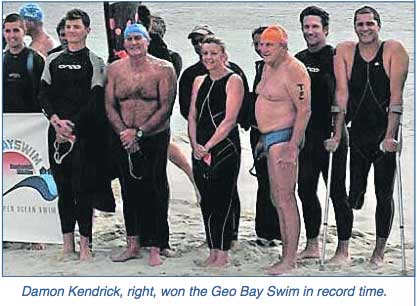
 DAMON Kendrick may have lost a leg to a shark attack when he was 14, but he is not one to shirk an ocean swimming challenge.
DAMON Kendrick may have lost a leg to a shark attack when he was 14, but he is not one to shirk an ocean swimming challenge.
So when a young competitor pointed at his leg before the
Geo Bay Swim on Sunday, and said “You better not beat me” it only made the Perth-based swimmer even more determined, even though another large shark had been spotted in the area around the time of the event.
“Right I thought – Game on,” he said. “All the way I imagined him 100m behind me and I had to stay ahead.
“I beat him by well over an hour and didn’t I enjoy rubbing his face in it.”
Not only did Damon beat that young bloke, but he also smashed the course record for the 20km swim by around 20 minutes as he was the first individual competitor to emerge from the water.
His time of four hours, 44 minutes, and 54 seconds was well ahead of second-placed Steve Wilson who came home in 5:19:32.
Damon lost his leg in South Africa while training to be a surf lifesaver when he was attacked by a shark just metres from the shore. "I was in the water, not even three feet deep when it grabbed me, shook me like mad, and then dragged me under," he said in a newspaper report in 2009. Damon
said he knew instantly what it was and thought he was going to die. But, he managed to survive the attack although his leg was so badly ravaged that it needed to be amputated. But, despite the encounter it hasn’t put him off the ocean and has since become a champion athlete. Earlier this year he became the first amputee to complete the Rottnest Channel Swim, he won two gold, two silver and a bronze medal in last year’s Pan Pacific Games, competing against able-bodied competitors and won numerous gold medals at the last two World Masters Games. He said the finish to the Geo Bay swim was difficult, despite the record time. “The tailwind helped fo the first 15 kms and then it worked against us. The final leg was brutal. I was 35 minutes ahead ofthe second solo and an hour ahead of the third.
Organisers of the Geo Bay Swim, from Quindalup to Busselton, said a shark sighting in the area on the weekend didn’t affect it – even with a team named Shark Bait among those competing.
SOURCE:
Busselton-Dunsborough Mail, November 16, 2011,
© Marie Levine, 1989.
Friday, December 30, 2011
Not Missing A Beat, Damon Kendrick Wins Geo Bay
 BUSSELTON, AUSTRALIA. If Damon Kendrick was a word, he would be all over the dictionary: courageous, positive, inspirational, unbelievable.
BUSSELTON, AUSTRALIA. If Damon Kendrick was a word, he would be all over the dictionary: courageous, positive, inspirational, unbelievable.
Damon lost his leg as a result of a shark encounter in South Africa at the age of 14, but his fast-paced life and exploits have not taken a hit. He became the first amputee to complete the 19.7K Rottnest Channel Swim in Western Australia.
But the multi-talented athlete from Perth really stepped it up at the 20K Geo Bay Swim from Quindalup to Busselton this month.
Especially since a large shark had been spotted in the area. "Right, I thought – game on," in words that make sense in a pool or basketball courts, but are unbelievable from a man without his right foot. "All the way I imagined him 100 meters behind me and I had to stay ahead. I beat him by well over an hour and didn’t I enjoy rubbing his face in it."
Damon won and set a new course record in 4 hours, 44 minutes and 54 seconds, ahead of second place Steve Wilson in 5:19:32.
Damon recalled when he lost his leg, thinking he was going to die. "I was in water, not even three feet deep when it grabbed me, shook me like mad, and then dragged me under. I remember drawing a breath and thinking it was the last breath I was going to take.." After his amputation, Damon thought, "I could cry, but what’s the point of that, it’s not going to bring my leg back. So I just thought I would do the best I can."
And his best is the best there is to offer.
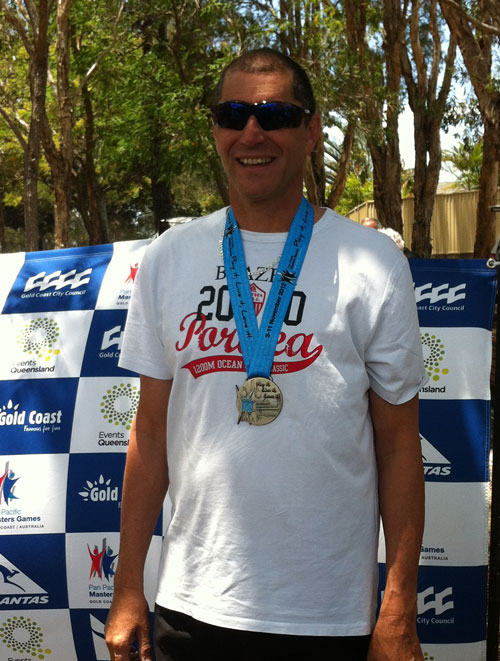
The loss of a leg to a shark 39 years ago has done nothing to quell Damon Kendrick’s love of swimming and the ocean.
The Zimbabwe-born 53-year-old, who now lives at Ermington in NSW, took the gold medal in the 5km open water swim (50-54 age group) today (Sunday) at the Pan Pacific Masters Games at Lake Hugh Muntz on the Gold Coast.
“I grew up in South Africa and I’ve lived here in Australia for the past 18 years,” said Kendrick.
“I was bitten by a shark when I was 14. It (missing the leg) doesn’t really affect me.”
Kendrick’s win on Sunday was as personally satisfying as it was hard fought. He beat home swimmers much younger and registered the fourth fastest time across all age categories.
“The wind was blowing hard and it made for some tough swimming at some parts of the lake,” said Kendrick.
“There was a guy just ahead of me (and) we swam around together for three laps and he pulled ahead of me just at the end.
“Most of the lake isn’t too bad, but down at the bottom corner it seems to get a huge chop.
“It‘s like the ocean and there is a surface current going in the opposite direction and you really have to fight your way back.
“It seemed to get worse each time, so I don’t know whether it was me getting tired or it was actually getting worse.”
The win rounded off a spectacular week of success that also saw him take the gold medal in the 400m freestyle and two silvers and a bronze in the swimming competition at the Southport Olympic Pool.
At the 2010 Pan Pacific Masters Games he delivered identical results, winning two gold, two silver and a bronze medal.
Kendrick said, despite its all-too-obvious perils, he has had a life-long love affair with the water.
“I was born into a swimming family. My mother was a swimming coach so I could swim before I could walk.
“At one stage I did gymnastics for a few years and then springboard diving and when the joints got sore I went back to swimming.
“I’ve since swam at the World Masters Games in Melbourne, Edmonton and Sydney.
“Edmonton and Sydney had a ‘swimmers with a disability’ category which was nice because I could pick up some more medals there.
“It was especially amazing going to Edmonton and being in a foreign country competing and meeting people from all over the world.”
Kendrick said that, unlike many things in life, age can bring distinct benefits to Masters participants.
“What I like is that most people fear getting old, but when you compete in Masters sport you look forward to getting older because you have an age advantage,” he said.
When asked about the possibility of returning in 2014 to defend his Pan Pacific Masters Games titles he responded immediately, “Oh yes, absolutely.”
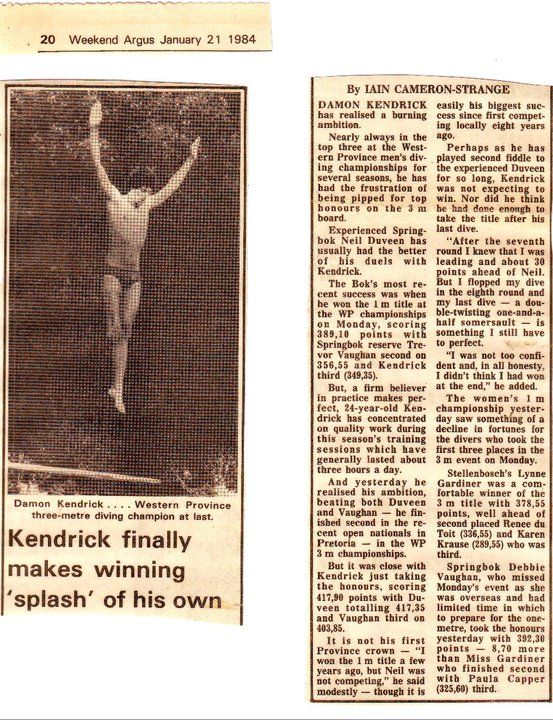
Everyday People – Damon Kendrick
Everyone who competes in endurance events is usually mentally tough and has battled through many obstacles. Damon Kendrick has overcome more hurdles than many, after losing half his leg during a shark attack in his teens. However, this has not prevented him from becoming a champion master’s swimmer, both in the pool and open water. Below he talks to us about his ultimate achievement, swimming a Rottnest Channel Swim solo crossing in 2011.
Name: Damon Kendrick
Age: 52
Resides: East Victoria Park, Western Australia
Tell us about swimming the Rottnest Channel (20km) solo in 2011.
Doing the Rottnest swim was not really on my radar for a long time. The first time I heard about the Rottnest swim was when I arrived to live in Perth 8 years ago. I thought that anyone who attempted the swim were crazy or had a death wish or both. Then a couple of people in the squad I train with did the swim. One of them was my very good friend Lyndal. She not only did it once, but twice, and she is terrifyingly NORMAL! That got me thinking that if she could do it, so could I. One day I was training at a local 50m pool when in walked my friend Paul Blackbeard. He used to be the captain of the South Africa swim squad, and at the peak of his swimming career, he was regarded in South Africa very much as we regard Thorpie in Australia. He said that he was doing the Rottnest swim and that it would be good for me to do that too. I am always up for a challenge and it didn’t take very much convincing that I should do it. After all, I had done some open water swims recently and I wasn’t as scared as I thought I would be.
I started to read up about the Rottnest swim and its history and I found a blog of Open Water swimming on the net. I also talked to a few people who had done the swim, particularly Lyndal and started to think about strategies and feeding regimes etc. My coach Stuart agreed to be my paddler and I started the task of trying to find a boat.
A requirement of the organisers, are that if you are a first-time swimmer, or have not done the swim in the past 5 years, then you have to qualify by swimming a 10km time trial in under 4 hours 15 minutes. I chose a 10km swim held at the Champion Lakes rowing facility in Perth for several reasons, no currents, no waves and no stinging or biting creatures. The swim was 4 laps of a 2.5 KM loop. We were not allowed paddlers and any food or drink had to be on a pontoon. I completed the swim in 2 hours 37 minutes 49 seconds, slightly disappointed that I did not manage to finish it in under 2 hours 30 minutes. Nevertheless, I came second in my age-group behind Paul who did it in 2:25:16.
On the morning of the swim, I was up before dawn preparing for the longest swim of my life. I usually get really nervous before any event and my partner knows to keep out of my way, do anything I ask and agree with everything I say. Sorted! This morning was different. I had no nerves at all. As we were driving I even commented that I still could not believe that I was about to attempt to swim the Rottnest Channel. It was a feeling of unreality, like I was watching a movie about my life, but this was fiction. I had not yet done what the movie was about. We arrived at Cottesloe beach in the dark and there were people scurrying all over the place and there were lights everywhere and registration tents. Registration opened at 5am and we got there at 4:40 am. I didn’t really know what to do with myself. I was in the first wave of starters which set off at 5:45am. The horn went off all too soon and I had no time to be nervous. I consciously tried not to sprint too hard at the start of the race as I did not want to blow out too early.
I had arranged for my paddler Stu to meet me just after the 1 km mark on the northern side of Cottesloe Beach. The rules of the race stated that your paddler had to have picked you up and your support boat needed to be accompanying you before you swam past the safety vessel anchored 1.5km off shore. I could see all around me that most of the swimmers had met their paddlers. That same awful feeling of being abandoned by my mother at school on the first day welled up inside me. I stopped, popped my head up and yelled STUART! “Here I am” he said. I hadn’t even seen that he had been following me for the past 300m. Serious swimming ensued. As the sun came up there were amazingly beautiful patterns of light dancing in the water. People had told me that apart from the shipping channel you could see the bottom the whole way across. It was true. My first water stop was at about the 3 km mark. After that I relied on Stu to stop me and give me water, gel, bananas and baby food. I felt really strong for a long time. I thought that after having seen the bottom for so long that swimming across the shipping channel would worry me but it didn’t. From the 11 km mark I had intermittent bouts of nausea. By this time Stu needed a break and Lyndal took over the paddling for a while. She said that it might be best for me not to fight it but to let it all go. I couldn’t do that, but at the 15 km mark I had no choice and I spewed my guts out.
I reached the 15 km mark in 3 hours and 45 minutes. Despite the vomiting, I still felt strong. Then a current came and dragged us southward. When I stopped next to the kayak for a drink, by the time I threw my water bottle back to my support crew I was 10 m away from where I had stopped. I now not only had to swim extra distance, I also had to swim against the current which meant my overall pace slowed, and I had to swim northwards to get back on track.
The last 5 km was not easy. I was battling fatigued shoulders, low nutrition, and a current. Never once did I think of giving up though. It simply did not enter my head as an option. At one point I felt I was getting nowhere as I could not see Phillip Rock, which indicated the 18 km mark of the race and shouted to Stu “Where is that *&#@ing rock?” He calmly pointed to it about 400m away. Then he told me I had to kick now. I felt a surge of energy knowing I was within reach but not daring to get excited about the finish. He pointed out the finish to me, several times. The trouble is that with goggles on and being at water level does not give one a good perspective for line of sight. The paddler is invaluable to a Rotto swimmer. There was a line buoys which started at 400m from the finish line and that was where Stu had to leave me and paddle on the other side. Only now did I feel that I could push to the end. I saw the finish, the people watching and could hear the commentary. I got to the shallows where my partner was waiting for me with my crutches. Exhausted yet elated, I finished in 6 hours 50 minutes. It had taken me 3 hours and 5 minutes to swim the last 5 kms, almost the same time it took to swim the first 15 km. I had just become the first amputee to complete the Rottnest Channel swim solo.
How difficult was it getting back into ocean swims after losing half your leg in a shark attack as a teenager? What inspired you to do so?
Having lost my leg in a shark attack when I was 14 years old as a newly qualified lifesaver on active duty, I have a healthy respect for the sea. I had never been as deep in and as far from the shore as when I did the Busselton Ironman swim. The jetty gave me some comfort as I felt that I could always get onto the jetty if something went wrong, or I was too paranoid. The day before the Busselton ironman I was really nervous and I had to go on a walk out to the end just to see what it was like and familiarise myself with the landmarks. When the race came, I was not any more nervous than I am at a pool event. It was just race nerves no more. I had no sense of paranoia which I thought I might have. The water was as flat as a swimming pool and crystal clear. It was really difficult to concentrate on swimming because of the myriads of different schools of fish. At one time I swam over the top of a whole school of small stingrays. It was simply magnificent. Somehow I felt at home in the water again.
Tell us about your comeback into open water swimming
I was doing swimming training with a triathlon squad, and one of the members had an injury which prevented him from running. I made the brilliant suggestion of why didn’t he get a team together for the Busselton Ironman and do the cycle. All he needed to do was find a swimmer and a runner. The very next session he asked me to swim. I thought about it for about 2 seconds and said yes. That year we came second out of 50 teams. The following year we won. I went on to do some half ironman team events as well and our teams always did very well.
I then competed in the Pan Pacific Masters Games in 2010 and I did 4 pool events and the 5 km open water swim at Lake Hugh Muntz, a fresh water lake on the Gold Coast. I came first in my age group and third overall and that gave me another boost.
You have a long history of achievements in masters swimming competitions. Tell us about some of your other results.
I come from a swimming family and gave up swimming first for gymnastics and then for diving. I dived at 9 consecutive South African National Championships from 1979 onwards. In 1980, I won the State championships for the first time, and in 1984 I came second in the National Open Championships. I only went back to swimming in my late 30’s in the Masters. In 2005, at the World Masters Games in Edmonton, Canada I won 5 gold medals swimming in the swimmers with a disability (SWAD) section. If I had been swimming in the able bodied section I would have had a 7th, 6th, 5th 4th and 2nd place. At the 2006 Pan Pacifica Masters Games I won 1 gold, 2 sliver and a bronze medal swimming against able-bodied swimmers. At the World Masters Games in 2009 in Sydney, I won 4 golds and 1 silver in the SWAD section. AT the 2010 Pan Pacific Masters Games I won 2 golds, 2 slivers and a bronze medal, again swimming against able bodied competitors. I currently hold the WA State masters record in 1500m in the 50-54 year age group.
What does a typical training week look like for you?
Out of competition season I swim three mornings a week from 5:30 am to 7:00 am. I usually swim between 4 and 5 km each session. In season, I boost the pool swimming to 4 times a week and add an open water swim once a week. That usually gives me about 22- 25 kms per week
You have overcome many obstacles in your life but have not let anything stand in the way of getting the most out of everything you do. What advice do you have for others on how to deal with setbacks or unfortunate events?
You cannot change the past, but you can change the future. Your attitude will make a huge difference to the way you experience the rest of your life. You cannot focus on what you don’t have, focus on what you do have and make the most of that!
So what’s next? Do you have any races/events/competitions on the horizon?
I have entered the Geo Swim in WA. That is a 20 km swim from Dunsborough to Busselton going around my favourite jetty again. Then I am heading off to Melbourne for the ‘Bloody Big Swim’ (yes, that it its official name!) swimming the 11.2 km form Frankston to Mornington
